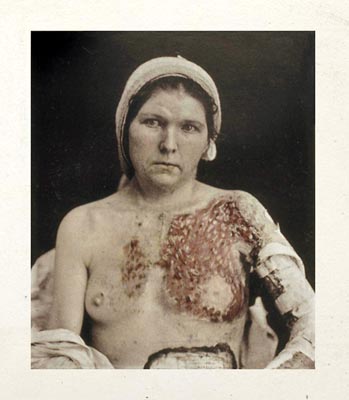
WAS ADMITTED to Bellevue Hospital, October 1871, for a burn from kerosene oil. After five months' treatment the wound assumed the appearance seen in the illustration. The nipple had been renewed and the wound of the left breast almost covered by grafts from her own person and those of her friends.
On March 10, 1872, I immersed an amputated leg in hot water and began grafting from it within three minutes after immersion. Thirty grafts were applied on the right side and covering a vertical space five by four and a-half inches, and almost all succeeded.
March 23.—Being unable to take the amputated limb immediately to my patient, I wrapped it in flannel and placed it behind a coil of steam pipes; beginning grafting one hour and thirty-five minutes after the operation. About one hundred grafts were applied, and on April 1, I counted eighty-nine successful ones.
On April 19, this photograph was taken to show the grafts of March 23. Another taken three months later, showed the breast nearly healed, and the arm much improved. An acute pleurisy with effusion of the left side then set in and caused her death on June 22, when everything promised success. A post-mortem showed that death was not directly due to the burn. She had received in all over 1500 grafts in less than a year; a large proportion of which were successful. (Dr. Geo. A. Van Wagenen, M.D., Late House Surgeon Bellevue Hospital).

I tried to rhyme her breasts with bits of skin
and patch her broken meters back to song.
But pain stitched on and on. No art that I'd enjoin
could lyric back her breasts from fire or mend
such loss—or make her husband kind:
he'd "never love a chest of scars."
So I was left to wooing with scalpels
and grafts, salves and sutures,
and the legs I'd warmed from cadavers.
Soon I'd learned her body like a lover.
But after the months of grafting,
so much intimacy without romance,
her life blistered with grief and grievance.
She'd take no more of my artless crafting,
and all my love and and all my skill flamed to nothing.
